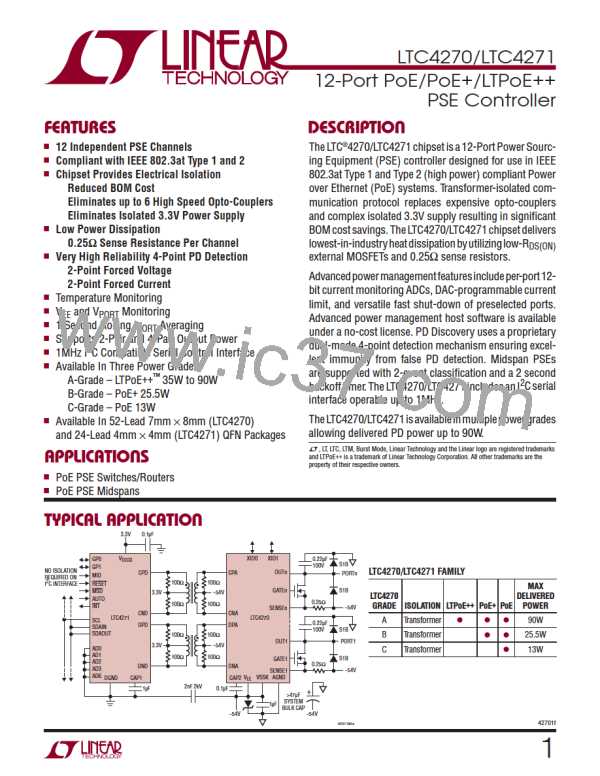LTC4270/LTC4271
APPLICATIONS INFORMATION
The LTC4270/LTC4271 chipset implements a proprietary
isolation scheme for inter-chip communication. This
architecture dramatically reduces BOM cost by replacing
expensiveopto-isolatorsandisolatedpowersupplieswith
a single low-cost transformer.
resistance and turns on the power. When the PD is later
disconnected, the PSE senses the open circuit and turns
power off. The PSE also turns off power in the event of a
current fault or short circuit.
When a PD is detected, the PSE optionally looks for a
classification signature that tells the PSE the maximum
power the PD will draw. The PSE can use this information
toallocatepoweramongseveralports,topolicethecurrent
consumptionofthePD,ortorejectaPDthatwilldrawmore
power than the PSE has available. The classification step
is optional; if a PSE chooses not to classify a PD, it must
assume that the PD is a 13W (full 802.3af power) device.
The LTC4270/LTC4271 comes in three grades which sup-
port different PD power levels.
The A-grade LTC4270/LTC4271 chipset extends PoE
++
++
power delivery capabilities to LTPoE levels. LTPoE
is a Linear Technology proprietary specification allowing
++
for the delivery of up to 90W to LTPoE compliant PDs.
++
TheLTPoE architectureextendstheIEEEphysicalpower
negotiation to include 35W, 45W, 70W and 90W power
levels. The A-grade LTC4270/LTC4271 also incorporates
all B- and C-grade features.
New in 802.3at
Thenewer802.3atstandardsupersedes802.3afandbrings
several new features:
The B-grade LTC4270/LTC4271 is a fully IEEE-compliant
Type 2 PSE supporting autonomous detection, classifica-
tion and powering of Type 1 and Type 2 PDs. The B-grade
LTC4270/LTC4271 also incorporates all C-grade features.
• A PD may draw as much as 25.5W. Such PDs (and the
PSEs that support them) are known as Type 2. Older
13W 802.3af equipment is classified as Type 1. Type 1
PDs will work with all PSEs; Type 2 PDs may require
Type 2 PSEs to work properly. The LTC4270/LTC4271
is designed to work in both Type 1 and Type 2 PSE de-
signs, and also supports non-standard configurations
at higher power levels.
The C-grade LTC4270/LTC4271 is a fully autonomous
802.3af Type 1 PSE solution. Intended for use only with
theAUTOpintiedhigh, theC-gradechipsetautonomously
supports detection, classification and powering of Type 1
PDs.AsaType1PSE,twoeventclassificationisprohibited
and Class 4 PDs are automatically treated as Class 0 PDs.
• The Classification protocol is expanded to allow Type 2
PSEs to detect Type 2 PDs, and to allow Type 2 PDs to
determine if they are connected to a Type 2 PSE. Two
versions of the new Classification protocol are avail-
able: an expanded version of the 802.3af Class Pulse
protocol, and an alternate method integrated with the
existing LLDP protocol (using the Ethernet data path).
The LTC4270/LTC4271 fully supports the new Class
Pulse protocol and is also compatible with the LLDP
protocol(whichisimplementedinthedatacommunica-
tions layer, not in the PoE circuitry).
PoE BASICS
Common Ethernet data connections consist of two or four
twisted pairs of copper wire (commonly known as CAT-5
cable), transformer-coupled at each end to avoid ground
loops. PoE systems take advantage of this coupling ar-
rangement by applying voltage between the center-taps
of the data transformers to transmit power from the PSE
to the PD without affecting data transmission. Figure 10
shows a high level PoE system schematic.
• Fault protection current levels and timing are adjusted
to reduce peak power in the MOSFET during a fault; this
allows the new 25.5W power levels to be reached using
the same MOSFETs as older 13W designs.
To avoid damaging legacy data equipment that does not
expect to see DC voltage, the PoE spec defines a protocol
that determines when the PSE may apply and remove
power. Valid PDs are required to have a specific 25k com-
mon mode resistance at their input. When such a PD is
connected to the cable, the PSE detects this signature
42701f
17

 Linear [ Linear ]
Linear [ Linear ]